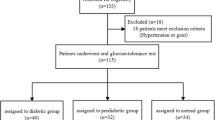Abstract
A technique is described for intramuscular measurement of muscle blood flow in the forearm, by using a 0.5-mm thin optical single-fibre for laser Doppler flowmetry (LDF) inserted percutaneously. Continuous recordings were performed of the brachioradial muscle during an 11-min series of alternating 1-min periods of increased static contraction and rest determined by an electronic handgrip forcemeter and surface electromyography (EMG) of the muscle. Stepwise increased handgrip contractions were performed at 10%, 20%, 30%, 40% and 50% maximal voluntary contraction (MVC). This was followed by a similar series of continuous contractions. Finally, an endurance test was performed with a handgrip force of 50% MVC maintained for as long as possible. A group of ten healthy men of different ages was studied. Signal processing was done on line by computer. Successive increases in rootmean square (rms)-EMG and a fall in the mean power frequency (MPF) of the EMG spectrum occurred during the series of static contractions, which evoked perceived local fatigue in the forearm. Muscle blood flow recorded simultaneously showed no change from resting level during contractions at 10%, 20% and 30% MVC, while at 40% and 50% MVC mean increases of 150% and 200% were recorded. Blood flows measured during the rest periods showed large variability with no significant changes. This was also found after continuous contractions of the same intensities. The endurance time was 1.2–3.5 min (mean 2.4 min). Muscle blood flow showed mean increases of 214%, 256% and 229% of resting level each minute of the maintained contraction. Nevertheless, EMG signs of local fatigue developed, such as a rise in rms-EMG and a fall in MPF, and the subject experienced local fatigue. To conclude, this technique of percutaneous, continuous LDF recorded, at high sensitivity, the microcirculation at different fluxes and EMG-defined muscle activity.
Similar content being viewed by others
References
Barcroft H, Greenwood B, Whelan RF (1963) Blood flow and venous oxygen saturation during sustained contraction of the forearm muscles. J physiol (Lond.) 168:848–856
Barnes WS (1980) The relationship between maximum isometric strength and intramuscular circulatory occlusion. Ergonomics Vol 23, 4:351–357
Basmajian JV, DeLuca CV (1985) Muscles alive. Their functions revealed by electromyography. Williams and Wilkins, Baltimore, Md.
Blomqvist CG, Lewis S, Taylor F, Graham RM (1981) Similarity of the hemodynamic responses to static and dynamic exercise of small muscle groups. Circ Res 48 (Suppl 1):87–92
Byström SEG, Kilbom Å (1990) Physiological response in the forearm during and after isometric intermittent handgrip. Eur J Appl Physiol 60:457–466
Humphreys PW, Lind AR (1963) The blood flow through active and inactive muscles of the forearm during sustained handgrip contractions. J physiol (Lond.) 166:120–135
Jensen BR, Fallentin N, Byström S, Sjögaard G (1993) Plasma potassium concentration and Doppler blood flow during and following submaximal handgrip contractions. Acta Physiol Scand 147:203–211
Kilbom A (1967) Circulatory adaptation during static muscular contractions. Scand J Work Environ Health 2:1–13
Kilbom Å, Persson J (1981) Circulatory response to static muscle contractions in three different muscle groups. Clin Physiol 1:215–225
Kontos HA, Richardson DW, Patterson JL Jr (1966) Blood flow and metabolism of forearm muscle in man at rest and during sustained contraction. Am J Physiol 211:869–876
Larsson S-E, Bodegård L, Henriksson KG, Öberg PÅ (1990) Chronic trapezius myalgia. Morphology and blood flow studied in 17 patients. Acta Orthop Scand 61:394–398
Larsson S-E, Cai H, Öberg PÅ (1993a) Continuous percutaneous measurement by laser-doppler flowmetry of skeletal muscle microcirculation at varying levels of contraction force determined electromyographically. Eur J Appl Physiol 66:477–482
Larsson S-E, Cai H, Öberg PÅ (1993b) Microcirculation in the upper trapezius muscle during varying levels of static contraction, fatigue and recovery in healthy women — a study using percutaneous laser-Doppler flowmetry and surface electromyography. Eur J Appl Physiol 66:483–488
Larsson S-E, Alund M, Cai H, Öberg PÅ (1994) Chronic pain after soft-tissue injury of the cervical spine: trapezius muscle blood flow and electromyography at static loads and fatigue. Pain 57:173–188
Lind AR, McNicol GW (1967) Local and central circulatory responses to sustained contractions and the effect of free or restricted arterial inflow on post-exercise hyperemia. J Physiol (Lond.) 192:575–593
Mark AL, Victor SH, Nerhed C, Wallin BG (1985) Microneurographic studies of the mechanisms of sympathetic nerve responses to static exercise in humans. Circ Res 57:461–469
Neter J, Wasserman J, Kutner MH (1989) Applied linear regression models (2nd edn). Irwin, Homewood, Ill.
Rang HP, Dale MM (1991) The Circulation. In Pharmacology, 2nd edition, Churchill Livingstone, pp 346–368
Sadamoto T, Bonde-Petersen F, Suzuki Y (1983) Skeletal muscle tension, flow, pressure, and EMG during sustained isometric contractions in humans. Eur J Appl Physiol 51:395–408
Salerud EG, Öberg PÅ (1987) Single fiber laser-Doppler flowmetry. A method for deep tissue perfusion measurements. Med Biol E'ng Comput 25:329–334
Sjögaard G (1991) Role of exercise-induced potassium fluxes underlying muscle fatigue; a brief review. Can J Physiol Pharmacol 69:238–245
Sjögaard G, Savard G, Juel C (1988) Muscle blood flow during isometric activity and its relation to muscle fatigue. Eur J Appl Physiol 57:327–335
Author information
Authors and Affiliations
Rights and permissions
About this article
Cite this article
Larsson, SE., Zhang, Q., Larsson, R. et al. Single-fibre laser Doppler flowmetry and electromyography for evaluating microcirculation in forearm muscle during static and continuous handgrip contractions. Europ. J. Appl. Physiol. 73, 219–224 (1996). https://doi.org/10.1007/BF02425479
Accepted:
Issue Date:
DOI: https://doi.org/10.1007/BF02425479




